To master soap trace speed, control your temperatures (keep oils around 21°C for slower trace, 30°C for faster reactions), choose oils strategically (olive oil slows trace, coconut oil accelerates it), and use your stick blender in short bursts followed by hand stirring. Adjust your water-to-lye ratio—more water means slower trace. Select fragrances carefully, avoiding florals and spices that accelerate reactions. These simple adjustments will transform your soap making journey from unpredictable to precisely controlled.
7 Second-Level Headings for "Master Soap Trace Speed With Simple Techniques"
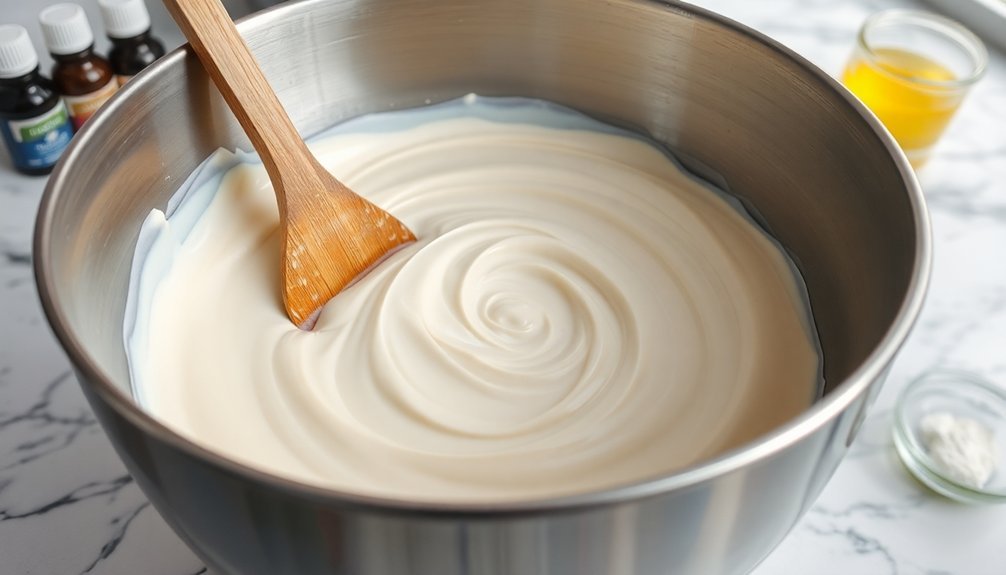
Five key strategies can transform how you manage soap trace development in your handmade creations. When crafting intricate designs, you'll want to extend your working time by understanding how to control the saponification process.
First, adjust your water content—higher amounts slow trace development.
Second, mind your temperature; cooler oils and lye solution give you more time before reaching thick trace.
Third, use your stick blender strategically with short bursts rather than continuous blending.
Fourth, select slower-moving oils like olive oil to naturally extend your light trace phase.
Finally, time your additives thoughtfully—adding fragrance oils after reaching light trace helps maintain workability.
These techniques give you precise control over how quickly your soap batter thickens, allowing for more detailed designs without rushing through the creative process.
Understanding the Science Behind Soap Trace Stages
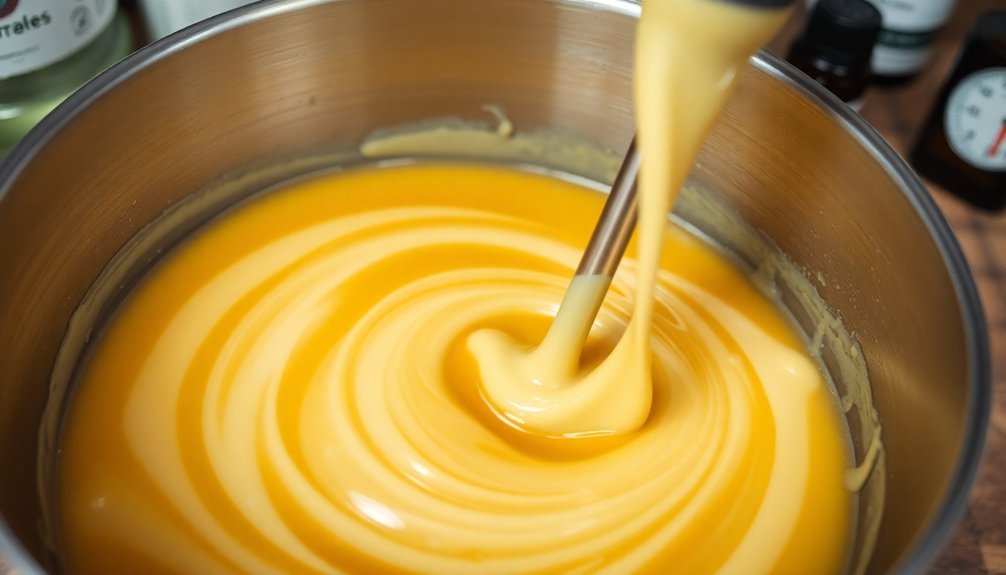
The chemical transformation during trace happens when your oils and lye create an emulsion, starting the saponification process that eventually yields solid soap.
You'll notice temperature greatly impacts this reaction—warmer mixtures accelerate trace while cooler conditions slow it down, giving you control over your working time.
Different oils in your recipe contribute unique properties to trace speed, with saturated fats like coconut and palm leading to faster trace than liquid oils like olive or sunflower.
Chemical Reactions Explained
Understanding saponification at its molecular level helps you master the art of soap making and control trace development. When oils and lye meet, they undergo an exothermic chemical reaction, breaking down fatty acid chains and forming soap molecules. This process generates heat, which directly impacts trace speed.
| Oil Type | Trace Effect | Chemical Reason |
|---|---|---|
| Saturated (coconut) | Accelerates | Tightly packed molecules react faster |
| Unsaturated (olive) | Slows down | Looser molecular structure |
| Essential oils | Varies | Depends on specific chemical compounds |
You'll notice your soap batter's emulsification progresses through distinct trace stages as saponification continues. Temperature control remains your most powerful tool—cooler temperatures slow the reaction, giving you more working time for complex designs. Conversely, higher temperatures speed up trace, making the shift from light to thick trace happen more rapidly.
Temperature's Pivotal Role
Precise temperature control stands at the heart of successful soap making, dramatically influencing how quickly your soap reaches trace. Warmer temperatures accelerate saponification, pushing your mixture to trace faster than you might anticipate.
When you need more working time for complex designs, maintain a cooler soaping environment around 21°C.
Remember that saponification is an exothermic reaction—it generates heat naturally. This self-produced warmth compounds when using a stick blender, potentially causing runaway acceleration.
During hot weather, you'll need to be especially vigilant as high temperatures can trigger rapid tracing that leaves little time for artistry.
To manage trace speed effectively, heat your oils to at least 30°C, giving you better control over the process while ensuring complete saponification.
This temperature balance becomes your most powerful tool for consistent results.
Oil Composition Effects
While temperature sets the stage for saponification, your oil selection ultimately determines how quickly trace develops. High saturated fats like coconut oil accelerate trace speed due to exothermic reactions during saponification, giving you less working time.
Conversely, unsaturated oils such as olive oil, rich in oleic acid, slow down the process, allowing for intricate designs.
The balance between hard oils and soft oils in your recipe directly impacts how quickly your soap batter thickens. Cocoa butter and palm oil lead to faster trace compared to their softer counterparts.
Additionally, your fragrance choice matters—clove and cinnamon essential oils notoriously accelerate trace.
Essential Oils and Butters: Impact on Trace Development
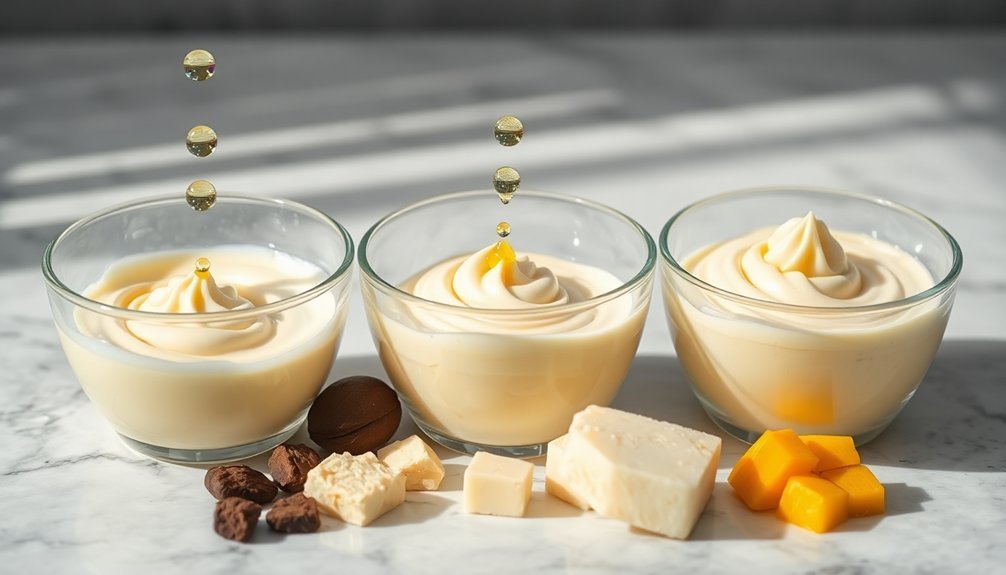
As you formulate your soap recipe, the choice of essential oils and butters dramatically influences how quickly your soap reaches trace. Clove and cinnamon essential oils accelerate trace speed due to their chemical composition, while lavender and citrus oils slow it down when added before colorants.
Hard butters like coconut oil and shea butter trigger faster saponification compared to olive oil, which provides extended working time. Be vigilant about fully melting solid butters—incompletely melted fats can cause false trace without proper emulsification.
Oils with high saturated fat content increase the exothermic reaction during saponification, hastening trace development. For complex designs requiring more time, try incorporating liquid lecithin (1 teaspoon per pound of oil) to slow the process, especially when using fast-acting fragrance oils.
Temperature Control Strategies for Predictable Trace
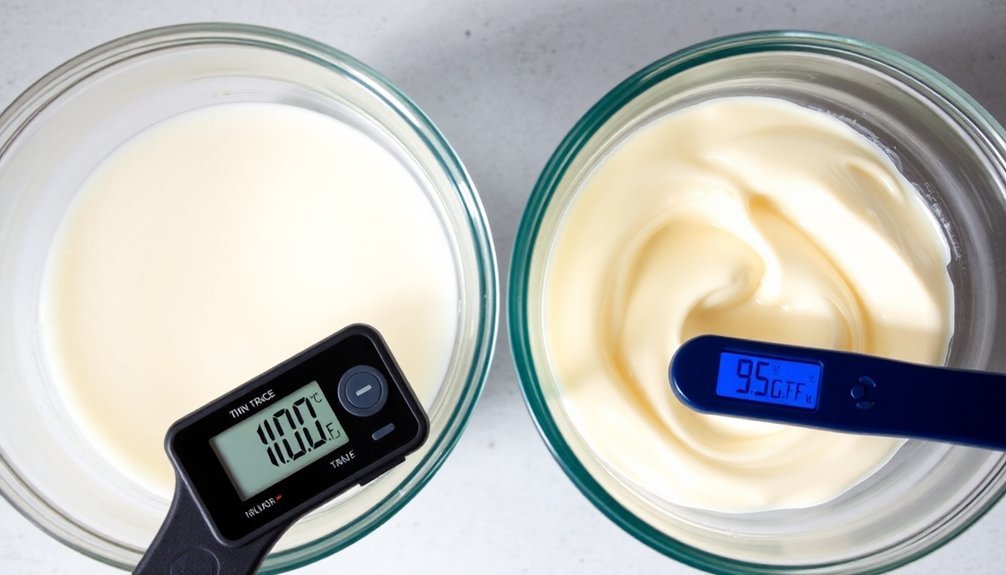
You'll find temperature management is one of your most powerful tools for controlling soap trace speed, with cooler temperatures around 21°C greatly slowing the process while higher temperatures above 30°C accelerate it.
Your ambient workspace temperature considerably impacts your batch's progression, especially during winter months when additional heat sources might be necessary.
Heat's Effect On Trace
Temperature stands at the forefront of variables affecting how quickly your soap batter reaches trace. Understanding how heat influences saponification allows you to control your soaping process with precision.
| Temperature Factor | Effect on Trace |
|---|---|
| Higher oil/lye temps (35°C+) | Accelerates trace considerably |
| Cooler ingredients (21°C) | Enables slower tracing for intricate designs |
| Stick blender usage | Adds heat through friction, speeds trace |
| Higher water content | Slows trace, extends working time |
| Lower water | Creates faster trace, reduces unmolding time |
Remember that saponification is exothermic—it generates its own heat as the reaction progresses. When you maintain oils and lye solution around 30°C, you'll achieve that balanced trace sweet spot, giving you ample time to create while ensuring the soap sets properly.
Cold-Process Temperature Balancing
Now that we comprehend heat's fundamental role in the soap-making process, let's focus on specific temperature control strategies that yield predictable trace results.
Maintaining oils around 21°C can greatly slow down trace, giving you extended working time for intricate designs in your cold process soap.
To control trace effectively, monitor your lye and water temperatures carefully. Using a higher water-to-lye ratio (1:1 solution) creates a more diluted environment that delays thickening.
Incorporate a high percentage of slow-moving oils like olive oil in your recipe for maximum working time.
Be mindful when using your stick blender—the friction generates heat that accelerates trace.
Blend in short bursts with rest periods to prevent unwanted temperature increases.
These temperature balancing techniques give you predictable, manageable trace every time.
Advanced Temperature Manipulation
While basic temperature control gives you a solid foundation, mastering advanced temperature manipulation techniques takes your soap making to professional levels.
For intricate designs requiring extended working time, cool both your oil and lye solution to below room temperature (around 21°C). This markedly slows trace speed, giving you precious minutes for swirls and layers.
Conversely, when you need rapid emulsification, place your oils in a warm water bath. Monitor temperature constantly—your stick blender generates heat that can unexpectedly accelerate tracing.
Don't overlook water amounts as a temperature management tool; higher water content slows progression to thick trace, while reduced water hastens it.
Stick Blender Techniques to Manage Emulsification Speed
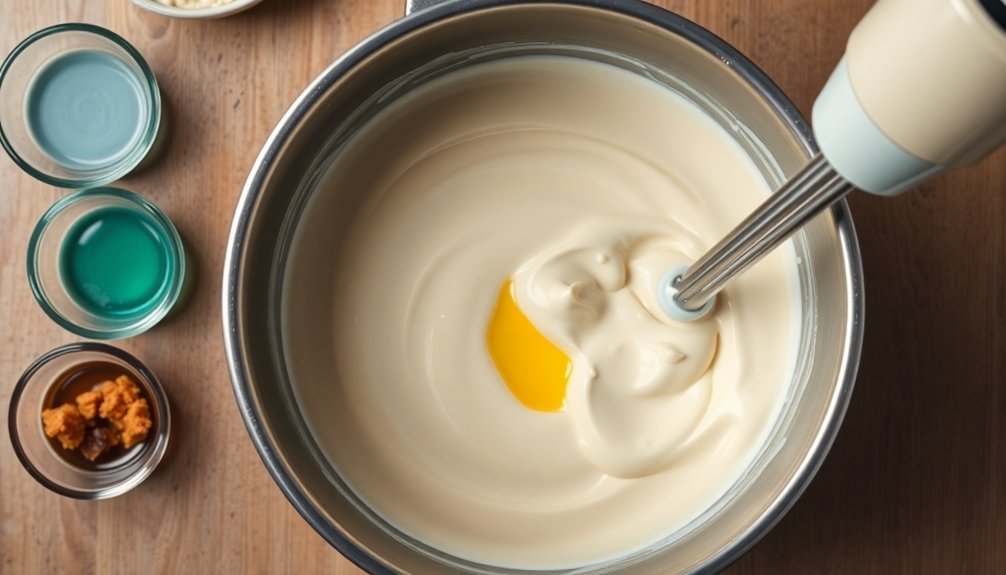
Although a stick blender dramatically accelerates the soap-making process, mastering its use is essential for controlling how quickly your soap reaches trace.
While hand stirring might take hours, your stick blender can achieve emulsification in just 1-2 minutes.
To control trace speed, use short bursts of blending followed by manual stirring. This pulsing technique allows you to monitor progression without over-thickening your batch.
For intricate designs, add fragrance oils known to accelerate trace only after reaching light trace.
Working in a cooler soaping environment naturally slows emulsification, giving you more time for detailed work before reaching thick trace.
Remember, over-blending is a common mistake—excessive blending immediately thickens your soap, limiting your design options.
With practice, you'll develop the perfect rhythm for your specific recipes.
Water-to-Lye Ratio Adjustments for Extended Working Time
Contrary to popular belief, water content greatly affects how quickly your soap batter reaches trace. While many soapers think more water slows trace speed, the opposite is true—lower water content typically extends your working time before reaching thick trace.
Consider maintaining a 1:1 water-to-lye ratio as your starting point. This balanced approach provides adequate trace control while ensuring proper saponification.
If you're creating intricate designs or incorporating multiple additives, you might benefit from reducing water in your soap recipe even further.
Don't hesitate to experiment with different water-to-lye ratios in your formulations. Running small test batches with varying liquid amounts will help you discover the perfect balance for your specific recipe.
These adjustments can give you precisely the extended working time you need without compromising your soap's quality.
Fragrance and Additive Selection for Slower Moving Batches
Beyond water ratios, your choice of fragrances and additives greatly impacts trace speed. Select essential oils like lavender and citrus to extend your working time, while avoiding floral fragrances and spicy oils that accelerate trace.
| Component | Slows Trace | Accelerates Trace |
|---|---|---|
| Oils | Olive oil, sunflower seed oil | Coconut oil |
| Fragrances | Lavender, Citrus (Lemon, Lime) | Ylang Ylang, Clove |
| Additives | Liquid lecithin (1 tsp/lb of oil) | Most synthetic additives |
Incorporate slow moving oils in your soap formulations to naturally delay trace. Consider using a higher water-to-lye ratio for additional working time. For natural trace management without synthetic ingredients, liquid lecithin works effectively. Always test fragrance oils in small batches first, as they can dramatically affect your soap's behavior.
Frequently Asked Questions
How Do You Make Soap Trace Faster?
To make soap trace faster, use a stick blender for quick emulsification, add fast-tracing oils like coconut and castor, warm your oils to 30°C+, choose accelerating fragrance oils, and reduce water in your lye solution.
Why Did My Soap Trace so Fast?
Your soap traced quickly likely because you're using fast-tracing oils, high temperatures, fragrance oils that accelerate, or over-blending. You might also have a low water-to-lye ratio in your recipe.
What to Do if Your Soap Won't Trace?
If your soap won't trace, make sure oils are fully melted, warm ingredients to 30°C, use a stick blender in short bursts, check fragrance oils aren't inhibiting trace, and consider reheating using hot process if it's still liquid.
What Happens if You Put Too Much Lye in Soap?
If you put too much lye in soap, you'll create a caustic product that can burn skin, cause irritation, and allergic reactions. Your soap will have unreacted lye because saponification can't complete properly.
In Summary
You've now gained valuable tools to control your soap's trace development. By manipulating temperatures, adjusting your stick blender technique, and selecting the right ingredients, you'll confidently handle both fast and slow-moving formulations. Remember that practice builds intuition—don't be discouraged by occasional accelerated batches. Apply these techniques consistently, and you'll soon master the perfect working time for every soap creation you imagine.

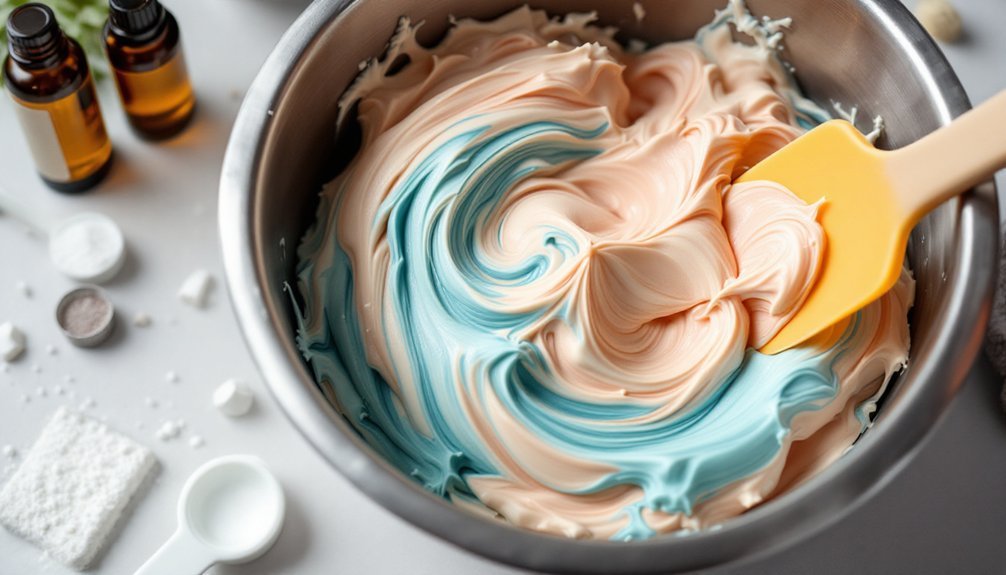



Leave a Reply